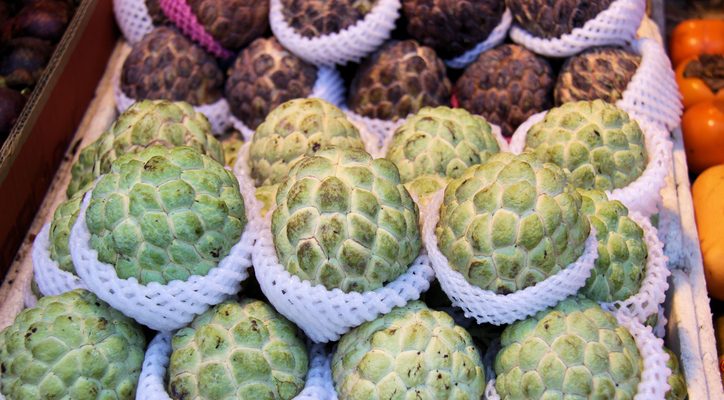
The atis fruit, or sugar apple, is the fruit of the Annona squamosa, which is native to the West Indies and tropical Americas like Mexico, Central America, and Peru.
Spanish and Portuguese traders are credited with first bringing it to Asia. In the Philippines, it is called the atis; in Burmese, it is the aajaa thee; in Bengali, it is ata; in Nepalese it is aati; and in India, it is the custard apple. It is also called sweetsop.
The atis fruit is considered a juicy and creamy fruit with a white pulp and up to 40 black seeds. Also, the exterior is knobbly, rough, and grayish-green.
The sugar apple is also loaded with health benefits. Let’s take a brief look at why the custard apple, aka atis fruit, should be included in your diet.
Atis Fruit Nutrition Facts
First off, the sugar apple pulp is high in carbs and is also rich in phosphorus, vitamin C, and calcium. The atis fruit seeds contain neutral resin and alkaloids.
It also has a sugar content ratio of 50% glucose and 50% sucrose. Other micronutrients found in atis fruit include:
- Vitamin B1
- Vitamin B2.
- Macronutrients
- Carbs
- Fiber
- Protein
- Iron
- Magnesium
- Vitamin B3
- Vitamin B6
- Copper
- Vitamin A
Let’s take a deeper look at some atis fruit nutrition facts. The following is a comprehensive atis fruit nutrition chart that contains credible information for one ounce, or 28g, of atis fruit.
| Nutrient | Amount | Daily Value |
|---|---|---|
| Calories | 28.3 | 1.00% |
| Carbohydrates | 7.1g | 2.00% |
| Fiber | 0.7g | 3.00% |
| Protein | 0.5g | 1.00% |
| Total Fat | 0.2g | 0.00% |
| Iron | 0.2mg | 1.00% |
| Calcium | 8.4mg | 1.00% |
| Magnesium | 5.0mg | 1.00% |
| Phosphorus | 5.9mg | 1.00% |
| Potassium | 107mg | 3.00% |
| Vitamin A | 9.2U | N/A |
| Vitamin C | 5.4mg | 9.00% |
| Vitamin B3 | 0.1mg | 1.00% |
| Vitamin B6 | 0.1mg | 3.00% |
* N/A—Not Applicable
10 Benefits of Atis Fruit
There are several tasty varieties of the custard apple, including Pinks mammoth, African pride, late gold, geffner, and Hillary White. With all the atis fruit nutrition, there are definitely a lot of benefits of eating such an exotic fruit.
Atis fruit benefits the body in a lot of great ways. Could atis fruit be the next big superfruit? Let’s take a look at 10 atis fruit benefits that make this fruit a valuable addition to your diet.
1. Can Improve Heart Health
The atis fruit may be valuable for improving heart health. For instance, the magnesium in custard apples may help relax the muscles and nervous system, and prevent against heart attacks and strokes.
Also, the fiber and vitamin B3 in atis fruit increases good HDL (high-density lipoprotein) cholesterol and lowers bad LDL (low-density lipoprotein) cholesterol.
2. May Help Prevent Asthma Attacks
Approximately one in 12 Americans suffer from asthma. Atis fruit’s high vitamin C content may decrease the risk of developing asthma attacks by keeping airways open. The vitamin B6 in atis fruit may also reduce bronchial inflammation and prevent asthmatic attacks.
3. May Help Lower High Blood Pressure
When blood pressure is too high, arterial walls become narrow or thick, and greater stress is placed on the heart. Atis fruit contains a good balance of sodium and potassium, which can help regulate and control blood pressure in the body.
4. Can Boost the Immune System
Atis fruit is a very good source of the antioxidant vitamin C, which contains anti-inflammatory and immune-boosting properties. The B vitamins in atis fruit can also help reduce fatigue and give you energy throughout your day.
5. Contains Anti-Cancer Properties
Atis fruit is also loaded with anti-cancer properties. For instance, the atis fruit bark contains tannins and astringent properties that help treat various cancers and tumors. The fruit of the custard apple contains acetogenin and alkaloids that also decrease the risk of cancer.
6. Promotes Good Brain Health
The B complex vitamins in atis fruit help control the gamma-aminobutyric acid (GABA) neuron chemical levels in the brain. This helps reduce irritability, tension, stress, and depression.
7. Can Reduce Risk of Arthritis
Arthritis is a degenerative joint disease that causes pain and swelling. The most common types of arthritis include rheumatoid arthritis and osteoarthritis.
The magnesium in atis fruit helps balance the water in the body, which may aid in removing acid from the joints. In turn, this can decrease symptoms associated with arthritis and rheumatism.
8. Helps Control Blood Sugar Levels
Diabetes is chronic problem that involves high blood sugar levels. Type 2 diabetes affects 90 to 95% of American diabetics. The fiber in atis fruit will slow the absorption of blood sugar in the body, which can reduce the risk of type 2 diabetes.
9. Great for Hair and Skin Health
Atis fruit’s vitamin C can also treat skin diseases and infections, including boils, eczema, psoriasis, and abscesses. The antioxidants in atis fruit are also great for rejuvenating the skin’s health and youthful look.
Atis fruit seed oil can also be applied to moisturize the hair, which can prevent hair loss, scalp inflammation, premature hair greying, dandruff, and a flaky scalp, while also stimulating the follicles for hair growth. The vitamin C, iron, and copper in atis fruit all make it fit for hair health.
10. Benefits Pregnant Women
Atis fruit contains folate, which is very important for pregnant women. The essential nutrient will help develop the brain, immune system, and nervous system of a fetus. Regular atis fruit consumption may also reduce the risk of miscarriage and minimize labor pain during childbirth.
How to Eat Atis Fruit
The best way to eat atis fruit is to cut it in half or pull it apart with your hands. Next, you will use a spoon and scoop out the flesh to eat it. You can also try adding a little lime juice for flavor.
The custard apple has been described as sweet custard combined with pear flesh or cooked apple. The atis fruit flesh closest to the skin can be a little bitter, and it is best to avoid it if you prefer a sweeter fruit taste. Once custard apples are ripe, store them in the fridge and eat them within two days.
There are also lots of delicious ways to enjoy an atis fruit. You can make a puree with the atis fruit flesh and process it through a high-powered blender or food processor. The puree is ideal for adding to coconut ice cream, yogurt, or homemade baked goods.
Custard apple can also be used to make custard apple sauce, custard apple cream, and caramelized custard apple bruschetta. With any new ingredient, it is definitely fun to experiment in new and exciting ways.
Conclusion
Now you know a little about atis fruit—a unique fruit that is native to the tropical Americas and West Indies. It also goes by several different names, such as the custard apple and sugar apple.
Although the atis fruit’s folate is beneficial to pregnant women, the roots are considered powerful enough to induce abortions. As a result, pregnant women should definitely avoid atis fruit roots.
If atis fruit is a fruit you are trying for the first time, keep it simple. Simply cut it in half, and scoop it out to eat the flesh of the fruit. Once you savor everything that is the atis fruit, you will be able to experiment with new and exciting healthy recipes.
Related:
- How Many Calories Does a Grapefruit Have? 5 Health Benefits of Grapefruit
- How to Eat Papaya: Some Delicious Papaya Recipes
- 10 Benefits of Pomegranate Juice
- Nance Fruit: Nutritional Value and Health Benefits
Sources:
“Custard-apple, (bullock’s heart), raw Nutrition Facts & Calories,” SELFNutritionData website; http://nutritiondata.self.com/facts/fruits-and-fruit-juices/1881/2, last accessed Jan. 24, 2017.
“How To Eat Custard Apples,” Buy Fruit website, March 29, 2016; https://www.buyfruit.com.au/blog/cooking-ideas/how-to-eat-custard-apples.
“32 Amazing Benefits and Uses of Custard Apples,” Health Beckon website, Jan. 28, 2014; http://www.healthbeckon.com/custard-apples-benefits/.
















